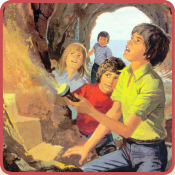
The Valley of Adventure

Book Details...
First edition: 1947
Publisher: Macmillan
Illustrator: Stuart Tresilian
Category: Adventure Series
Genre: Mystery/Adventure
Type: Novels/Novelettes
Publisher: Macmillan
Illustrator: Stuart Tresilian
Category: Adventure Series
Genre: Mystery/Adventure
Type: Novels/Novelettes
On This Page...
Reprints
1. 1960 Thames, illustrations and cover by Stuart Tresilian
2. 1968 Armada, illustrations by Stuart Tresilian, cover uncredited
3. 1975 Piccolo, illustrations by Stuart Tresilian, cover by Juliet Stanwell-Smith
4. 1983 Macmillan, illustrations by Stuart Tresilian, cover by Pamela Goodchild
5. 1983 Macmillan, illustrations by Stuart Tresilian, cover by Pamela Goodchild
6. 1988 Piper, not illustrated, cover by Lynne Willey
7. 1993 Piper, not illustrated, cover by Peter Mannim
8. 1998 Macmillan, not illustrated, cover by Peter Mannim (hardback edition)
9. 2000 Macmillan, not illustrated, cover by Larry Ronstant
10. 2007 Macmillan, not illustrated, cover by Melvyn Grant
11. 2008 Macmillan, not illustrated, cover by Stuart Tresilian
12. 2014 Macmillan, not illustrated, cover by Rebecca Cobb
13. 2021 Macmillan, illustrations and cover by Stuart Tresilian
2. 1968 Armada, illustrations by Stuart Tresilian, cover uncredited
3. 1975 Piccolo, illustrations by Stuart Tresilian, cover by Juliet Stanwell-Smith
4. 1983 Macmillan, illustrations by Stuart Tresilian, cover by Pamela Goodchild
5. 1983 Macmillan, illustrations by Stuart Tresilian, cover by Pamela Goodchild
6. 1988 Piper, not illustrated, cover by Lynne Willey
7. 1993 Piper, not illustrated, cover by Peter Mannim
8. 1998 Macmillan, not illustrated, cover by Peter Mannim (hardback edition)
9. 2000 Macmillan, not illustrated, cover by Larry Ronstant
10. 2007 Macmillan, not illustrated, cover by Melvyn Grant
11. 2008 Macmillan, not illustrated, cover by Stuart Tresilian
12. 2014 Macmillan, not illustrated, cover by Rebecca Cobb
13. 2021 Macmillan, illustrations and cover by Stuart Tresilian

Wraparound dustwrapper from the 1st edition, illustrated by Stuart Tresilian

Wraparound dustwrapper from the Thames reprint, illustrated by Stuart Tresilian

1st German edition published by Erika Klopp Verlag in 1951,
illustrated by Walter Born

Early German reprint published by Erika Klopp Verlag,
illustrated by Juliane van Dorp
German: Das Tal der Abenteuer
French: Le Mystère de la cascade (Arthur & Cie a la Cascade)
Dutch: De vallei van avontuur
Spanish: Aventura En El Valle
Portuguese: A Aventura no Vale
Swedish: Aventyrens Dal
Finnish: Seikkailujen Laakso
Icelandic: Aevintyradalurinn
Czech: Tajemne Udoli
Malaysian: Pengembaraan Di Lembah Terasing
Indonesian: Petulangan Di Lembah Maut
Brief Summary by Courtenay Rule: Philip, Dinah, Jack and Lucy-Ann are thrilled when their detective friend Bill invites them on an overnight trip in his new aeroplane. But things go unexpectedly and horribly wrong — and the four children find themselves stranded in a wild, lonely valley, along with a group of men who are clearly up to no good. What secret does the beautiful but apparently inescapable valley hide, and can the children find it before their enemies do?
Full Review (This may contain spoilers):
Anita Bensoussane's Review
Jack, Philip, Dinah and Lucy-Ann are to go on a night flight in Bill's new aeroplane and spend a few days at his peaceful countryside home in order to study wildlife. However, the children board the wrong plane and find themselves being flown by two South American men (Juan and Pepi) to a deserted valley in Austria, surrounded by high mountains. Not liking the look of the men, chiefly because they've got "such thick necks,"(!) the children slip out of the plane unseen in the hope of finding help but the valley is uninhabited and the few houses they come across are burnt and half-ruined.
The children's main worry at first is that they have very little to eat: "An adventure was one thing — but an adventure without anything to eat was quite another thing. That wouldn't do at all." Luckily, Juan and Pepi have a hut stocked with tins of food which the children raid when the men are elsewhere.
Near a huge waterfall, the children find a cave whose entrance is hidden by fronds of fern and make their home there. As usual, Philip has by now acquired a pet — a lizard named Lizzie.
The men's plane flies off, returning with a third man named Luis and an Austrian prisoner called Otto Engler, who knows whereabouts in the valley valuable items are hidden. They were hidden during the last war, in which houses were burned and many were killed. That the war was the Second World War becomes clear at the end of the book, when Bill remarks that the South Americans are in touch with the Nazis. Juan and his accomplices treat Otto badly, beating and starving him despite the fact that he is ill, in an attempt to force him to tell them where the treasure is hidden.
Otto sets the men on a false trail but draws a proper treasure map for Jack, as well as a map showing the way to the only pass leading out of the valley. He wants Jack and the others to leave the valley and seek a man named Julius Muller, who fought against the enemy during the war and is now working to recover Austria's lost treasures.
It is a blow for the children when they journey to the pass to find that it was bombed during the war and is now blocked with huge boulders. The only thing that cheers them up is that they will now have the thrill of following the treasure map for themselves, rather than leaving the treasure hunt to Julius.
After following various signs on the map, the children come to a collection of caves and passages in the mountainside. The first cave is festooned with stalagmites and stalactites which have joined to form columns and Jack says: "It's like an enormous underground cathedral — it just wants an organ to begin playing a grand and magnificent hymn." All the caves fill the children with awe and wonder and the treasures they contain are breathtaking. There are richly-adorned statues taken from churches, large paintings, old books and documents, and chests of gold coins. Beyond the caves are two cell-like rooms inhabited by an elderly Austrian couple, who have lived cut off from the world for years, guarding the treasures of the nation and awaiting the end of a war which, unknown to them, is already over.
It is not long before Juan, Pepi and Luis discover the whereabouts of the treasure and bring more men to help them carry it away, realising that it will take several trips to remove it all. They imprison the children and the old couple in the caves but Philip manages to slip out, hide in one of the men's planes before it takes off from the valley, and fetch help on reaching mainland Britain.
The capture of the men is exciting and, when we learn that Julius has applied for permission to have the pass unblocked, we are left with the impression that life will return to the valley and the treasures will be restored to their rightful places.
This tale, set in a valley which is both eerie and enchanting, is full of atmosphere and quite moving in places — it has always been my favourite of the Adventure books. These illustrations are hidden by default to ensure faster browsing. Loading the illustrations is recommended for high-speed internet users only.








